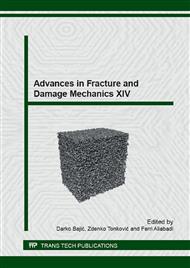p.1
p.5
p.9
p.13
p.17
p.21
p.25
p.29
Influence of Small Cavity Existing in the Vicinity of 3D Crack Front
Abstract:
In this paper, the interference between arbitrary shaped 3D planar crack and cavity existing in the vicinity of the crack front is evaluated. It is assumed that the treated region is unbounded and subjected to uniaxial tension at infinity. The interaction between crack and cavity is treated by body force method. The surface of the crack and cavity is modeled by number of small triangular elements and the density of body force and weight function of the force doublet is assumed at a constant on each triangle. Numerical stress analyses are examined by changing the radius of cavity and the distance between the cavity and crack front systematically. Numerical results are presented for the stresses along the centerline between cavity and crack. To validate the current analysis, numerical results are compared with the results in the literature and found good agreement.
Info:
Periodical:
Pages:
5-8
Citation:
Online since:
September 2015
Authors:
Keywords:
Price:
Сopyright:
© 2016 Trans Tech Publications Ltd. All Rights Reserved
Share:
Citation:


